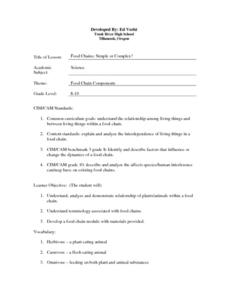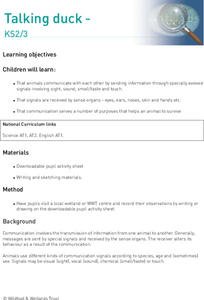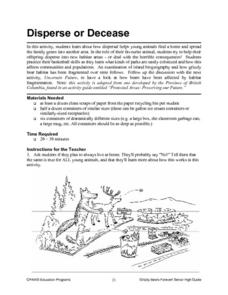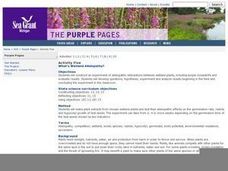Curated OER
It Takes All Different Kinds
Fourth graders are introduced to the types of jobs a veterinarian does in a typical day. In groups, they brainstorm a list of items they believe they do and discuss how they help animals live healthy lives. They also complete an...
Curated OER
Nature and You
Students recognize the story of creation in the Bible and begin to discuss endangered animals. In this creation lesson, students focus on a specific species that is endangered and complete a worksheet on how to save them. Students make...
Curated OER
Johnny Appleseed
Students investigate Johnny Appleseed. In this cross curriculum literacy and U.S. history instructional activity, students listen to Johnny Appleseed by Steven Kellogg, and dictate important events in his life as the teacher writes...
Curated OER
What Flies?
Young learners consider what flies and what kinds of sounds airplanes, animals, etc. make when they fly. They also get to generate a brainstorm list. Children discuss what the categories should be once the list is completed. Some really...
Curated OER
Cicada Invasion
Students consider how some animals, periodical cicadas, survive well in a particular environment due to the species' life cycle. They have a discussion about life cycles and how a particular species' life cycle helps it to survive....
Curated OER
Taming Wild Land
Third graders consider the habitat needs of living things and how extensive farming in an area can affect the plants and animals of a region. They participate in a simulation to show how changing the habitat in one area can greatly...
Curated OER
Food Chains: Simple or Complex?
Students explore the relationships within the food chain between plants and animals. They construct modules of food chains, keeping them simple and not complex. They focus on what the animals eat and not on what eats it.
Curated OER
Talking Duck
Students study how animals communicate through their senses and signals. They investigate how animals survive using their communication skills and create a commercial based on the research.
Curated OER
Living On Earth
Students discover the many different animals within various habitats and discover how each individual species interacts with its particular environment. Through charting different animals and their distinct habitat and matching animals...
Curated OER
Curriculum Activities: Ecological Concepts
Students explore a variety of microclimates to develop an awareness of why organisms live where they do. Moisture, time of day, land cover, and temperature form the basic concepts of this investigation.
Curated OER
Dependence and Interdependence
Third graders explore the dependence and interdependence that plants and animals in every environment have on one another. They examine how plants and animals depend on each other for survival. Students complete a variety of experiments...
Curated OER
Disperse or Decrease
Students explore the dispersal of animals.. Students take on the role of a specific animal. They simulate finding a new home due to overpopulation. Through hands-on activities performed during the simulation, students discover the area...
Curated OER
Habitats
Students examine how different living things interact with their environment. As a class, they discuss the characteristics of a habitat and write the list on the board. In groups, they focus on one habitat and create a mural of the...
Curated OER
My Favorite Animal
Young scholars research an animal of choice and create a project. In this animal science lesson, students choose an animal living in the International Peace Park to research. Young scholars write a paper and create a project...
Curated OER
7th Science Quiz
This seventh grade life science quiz has a professional appearance and well-written multiple-choice questions. However, it seems to cover too broad a variety of biology topics for only 15 questions to fully assess. There is one question...
Curated OER
Climatic Zones
Third graders recognize and locate Frigid, Temperate, and Torrid climatic zones on the word map or globe. They explain that plants, animals, and human societies display adaptations to the climates they live in .
Curated OER
In the Company of Wild Butterflies
Young scholars discover the life cycle of a butterfly and explain the different stages. In this exploratory lesson students watch a video and create insect art and they will get an opportunity to view live specimens of...
Curated OER
Mammals
Pupils gather information from an online database about mammals. Choosing one mammal, they compare its physical characteristics, food habits, behavior and location to the other mammals they were introduced to in this lesson. In groups,...
Curated OER
All Ears for Adaptation
Students discuss different characteristics that enable animals to adapt to their environments. They work in pairs with one partner standing about one foot behind the other partner and cup their hands around their ears with palms forward....
Curated OER
Are You Aware?
In this reading comprehension worksheet, students read several short paragraphs about farm animals and then answer five multiple questions about each paragraph.
Curated OER
Water Around Us
Students create a collage of human land use activities around a body of water. Students evaluate the effects of different kinds of land use on wetland habitats, and create a list of pros and cons for each land use.
Curated OER
What's Wetland Allelopathy?
Students study plants and what they need to thrive and survive. They make plant extracts from chosen wetland plants and test their allelopathic effects on the germination rate, radicle growth, and hypocotyl growth of test seeds of other...
Curated OER
Pets Around the World
Students communicate via e-mail with other students to learn about pets, animals of interest , and geography from different parts of the world. Vocabulary focuses on rural, urban, and suburban areas.
Curated OER
Classification Scheme
Fourth graders discuss different classification schemes for living organisms. They group common household items to discover many ways to classify organisms. Students compare/contrast characteristics of each classification.

























